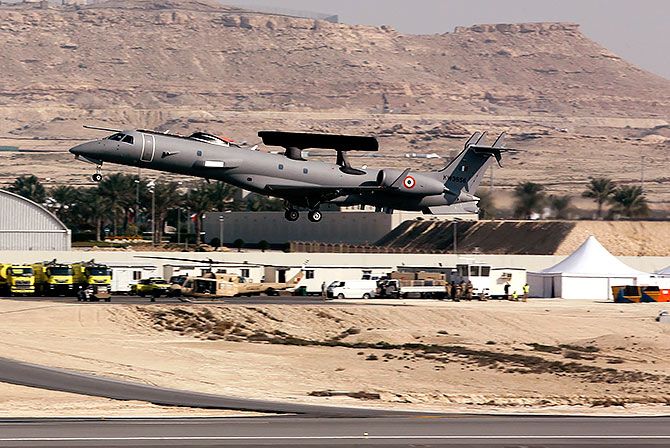 | « Back to article | Print this article |
'If UAV technology is used by the adversary to target VIPs or strategic targets it would be a different ball game altogether,' says Group Captain Murli Menon (retd).

The recent drone/cruise missile strike carried out supposedly by Yemeni Houthi rebels against Saudi oil farms nearly had the entire world up in arms.
The advent of unmanned aerial vehicle technologies has posed unique challenges to the air campaigner.
The limitations of a low cost drone notwithstanding, in terms of any substantial load or weapon carriage or war waging capability, given the vulnerabilities of soft civilian targets as seen in Saudi Arabia they could create considerable damage.

Also dropping of AK-47s, RDX and the like affords non State and other actors a new effective means of sub conventional war waging.

If media reports are to be believed, neither the indian Air Force nor the Border Security Force/army were able to detect the drone activity over the Line of Control/international border airspace in Punjab.
Of course, air defence of Indian airspace and the tactical battle area is the IAF's responsibility and I am sure action would be at hand to counter this threat.
Even in the past the IAF has addressed these issues effectively employing suitable radar and weapon combines.
The problem with UAV neutralisation is its low radar cross section and low speed, which makes a tactical weapon solution challenging especially at night.
But there are enough options with the IAF/army in terms of tactical radars AEW/AWAC/aerostats to provide timely drone detection over any given sector.
And as far as shooting it down is concerned, use of attack helicopters, trainer aircraft such as the Hawk or Pilatus class of aircraft could be considered as they would be more in synch with the UAV operating regime specially of speed and altitude.
More so, when drones are used by the adversary to abet his terror campaign and drop small arms etc, the IAF needs to consider offensive action to target the launch pads themselves.

Aggressive electronic interference with UAV operating frequency should also be attempted to lead the drones astray.
There have been techniques evolved of using an aerial net system to snatch aerial drones in flight.
The intention should be to deny the enemy use of this platform, however nuisansical their employment may be.
If the technology is used by the adversary to target VIPs or strategic targets it would be a different ball game altogether and aerial or other counter action would become imperative.

Aerial warfare has been a continuous see saw of offence and defence.
Every offensive action elicits a novel defensive action.
Use of low speed counter insurgency aircraft is another option to target the UAVs themselves or launch pads across the border.
It is not as though drones would replace manned fighters in a hurry. Yes, UCAV technology could open up interesting possibilities.
But the entire spectrum of manned assets and the electronic warfare spectrum needs to be exploited to counter the UAV threat.
Cost effectiveness would be an important consideration alright.
We may not like to deploy a BVR class of aerial weapon against a low cost UAV, hence the various options suggested.
